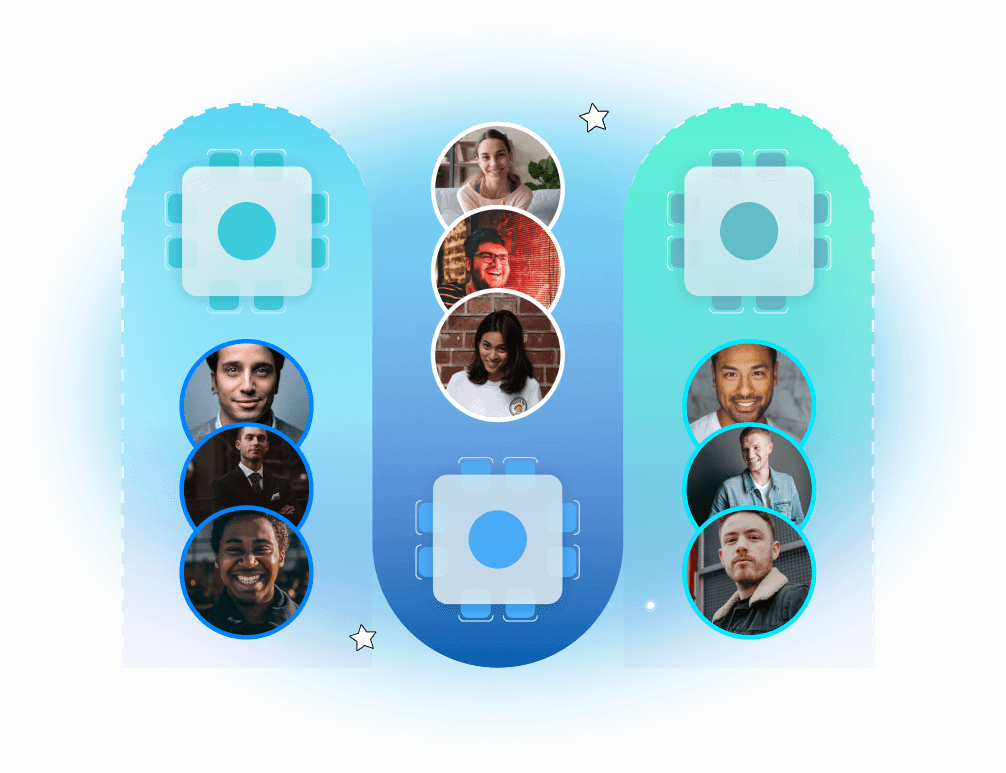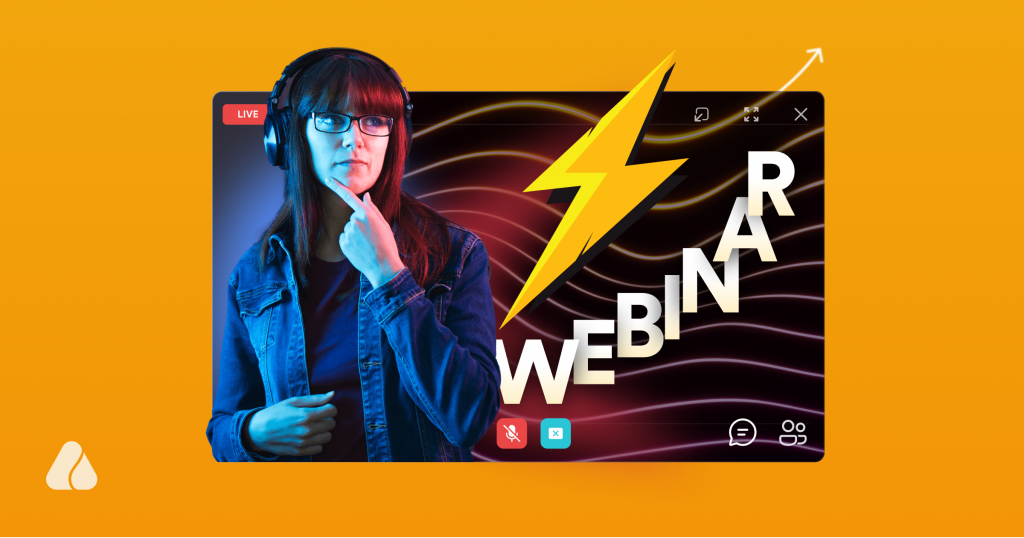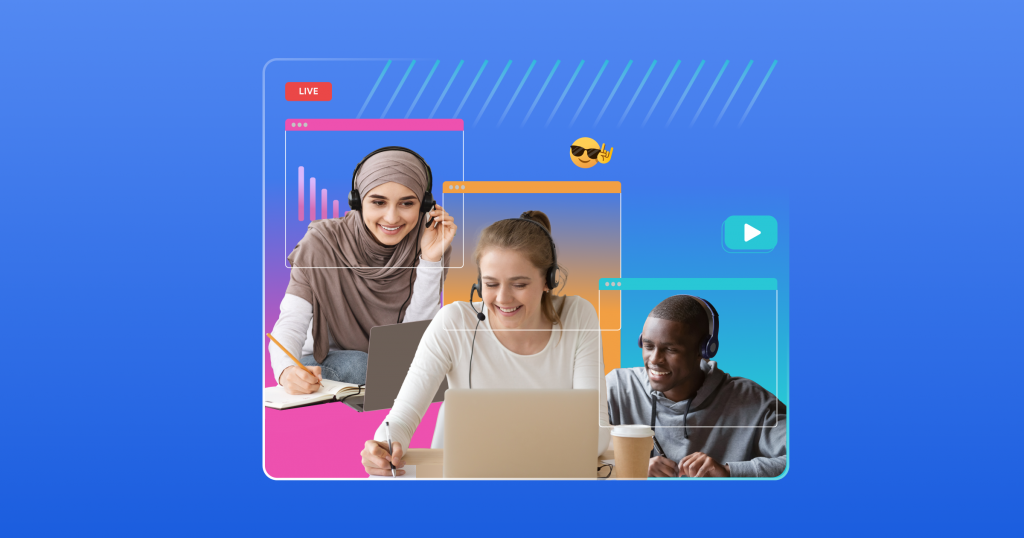
Unfortunately, in many cases the answer is often no. This high-quality content may fail to reach the right people and end up underutilized.
This disconnect can be attributed to several factors, such as different time zones, demographic diversity, or language preferences.
This is where on-demand webinars come in, serving as a powerful solution for organizations to re-utilize the existing content, enabling them to bridge these gaps and extend their reach to global audiences.
On-demand webinars not only enable businesses to repurpose their content but also empower them to capitalize on this version to create hundreds of personalized, multilingual content pieces in different formats.
In this blog, you’ll discover:
- Why are on-demand webinars important for your content strategy?
- In how many ways can webinar content be repurposed? And
- Top tips to fine-tune your on-demand webinar repurposing and content strategy.
Why On-Demand Webinars Are Important

By incorporating on-demand webinars in your content strategy, you can:
Eliminate geographical and time barriers
On-demand webinars eliminate geographical and time barriers, allowing your registrants, attendees, and potential viewers to access the content from any location, at any time.
This flexibility enables you to re-engage with existing stakeholders while also extending reach to new global audiences, amplifying your impact without any limitations.
Repurpose content
On-demand webinars allow companies to reuse the same content in different formats and versions. From creating a blog post to email follow-up content to video snippets and autonomous webinars, you can transform content based on business needs and requirements.
Encourage Reach and Teach
These webinars allow you to gain more viewers and attraction with time, significantly expanding your audience reach. They also serve as a medium to educate viewers on various topics, such as skill development, career growth, industry updates, and more, providing evergreen, free, and consistent educational value.
Ensure validated and sharp content
With on-demand webinars, you can fine-tune your content before making it available for a broader use. You can edit out the irrelevant portions, shorten the duration, enhance the video/audio quality, and incorporate subtitles.
Moreover, you can tailor the on-demand version based on the feedback and engagement from live attendees. By highlighting key discussions or segments that received more attention, you create a more validated, focused, and personalized experience that resonates better with future viewers.
Amplify prospect engagement
By making webinars available on-demand, you allow potential customers to engage with the content at their own pace. This extended flexibility and accessibility leads to ongoing interactions, further questions, and deeper engagement with prospects who might have missed the live session but are still interested.
Generate marketing and promotional content
The content from on-demand webinars can be transformed into summaries, key takeaways, highlights, smaller clips, speaker insights, or case studies for use in marketing campaigns.
You can create content in different formats and utilize them for social media promotions, email marketing campaigns, newsletters, or paid ads.
Support lead nurture campaigns
On-demand webinars are a great tool for nurturing leads. Prospects who aren’t ready to make a decision immediately can be engaged through on-demand webinar links or repurposed content as a part of an ongoing nurturing campaign.
During the nurturing process, you can also share on-demand versions of past webinars and customer stories that align with their specific interests and industry.
This approach helps build credibility and trust by showcasing relevant success stories and insights. Ultimately, it creates a positive impression and ensures consistent, high-quality engagement, keeping your brand top of mind as prospects move through the decision-making process.
On-Demand Webinars: 12 Effective Content Repurposing Strategies for Marketers
On-demand webinars provide marketers the flexibility to create versatile, repurposed content that can be leveraged to engage prospects and potential customers across various stages of the buyer’s journey.
In this section, you’ll discover strategies for repurposing webinar content to support both Top of the Funnel (TOFU) and Bottom of the Funnel (BOFU) initiatives, maximizing the value of your webinar material and extending its lifespan.
Content repurposing strategies for TOFU initiatives
At this stage, the goal is to raise awareness and attract new leads by delivering engaging, informative content.
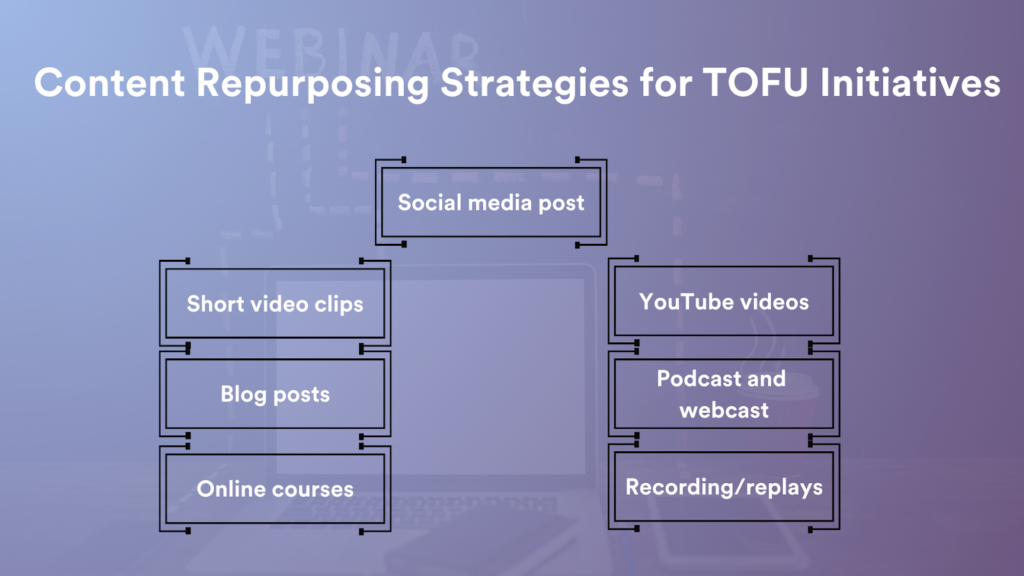
1. Social media post
Break your webinar content into bite-sized insights, the webinar overview, or important highlights to share on LinkedIn, Twitter, or Instagram. These snippets can tease key moments from the webinar, encouraging potential leads to watch the full on-demand session.
2. Short video clips
Create engaging 30- to 60-second clips from your webinar covering key takeaways, quotes from speakers, or summarizing the overall content. These can be shared on social platforms or your follow-up campaigns to capture attention quickly and persuade viewers to explore the full content.
3. YouTube videos
Upload the full webinar recorded version or personalized shorter segments on YouTube. Use proper tagging and keyword optimization in the title and description to gain traction among a wider audience through search.
4. Blog posts
Transform your webinar content into blog posts or articles that summarize the core ideas. By repurposing your webinar into written content, you offer your audience a descriptive overview of the discussions and interactions, increasing the likelihood that they will visit the recorded webinar or its on-demand version for more in-depth insights.
5. Podcast and webcast
Convert your live webinar or on-demand version into a podcast or webcast series. This expands your reach to audiences who prefer listening on the go. This also enables you to attract more viewers and drive more leads.
6. Online courses
Transform your educational webinars into structured online courses. By segmenting both on-demand and scheduled webinars, you can create a series or guide tailored to different industries, skill sets, or career development paths.
This strategy enhances brand visibility and attracts prospects by offering relevant courses and easy-to-access guides. It also provides deeper learning experiences, helping to nurture leads further down the funnel.
7. Recording/replays
Offer your registrants, including no-shows and attendees, direct access to the full webinar recording, either as an instant replay or an on-demand/autonomous session.
This demonstrates goodwill by giving your audience evergreen access to the content, allowing them to watch and revisit it at their convenience.
This approach not only adds value but also increases the potential for converting these individuals into leads and advancing them further down the funnel.
Read: Transform Webinar Recordings into Powerful Assets!
Content repurposing strategies for BOFU initiatives
At this stage, the focus is on converting leads into customers by delivering highly relevant, personalized content to support the lead’s decision-making, showcasing your solution’s value and credibility.
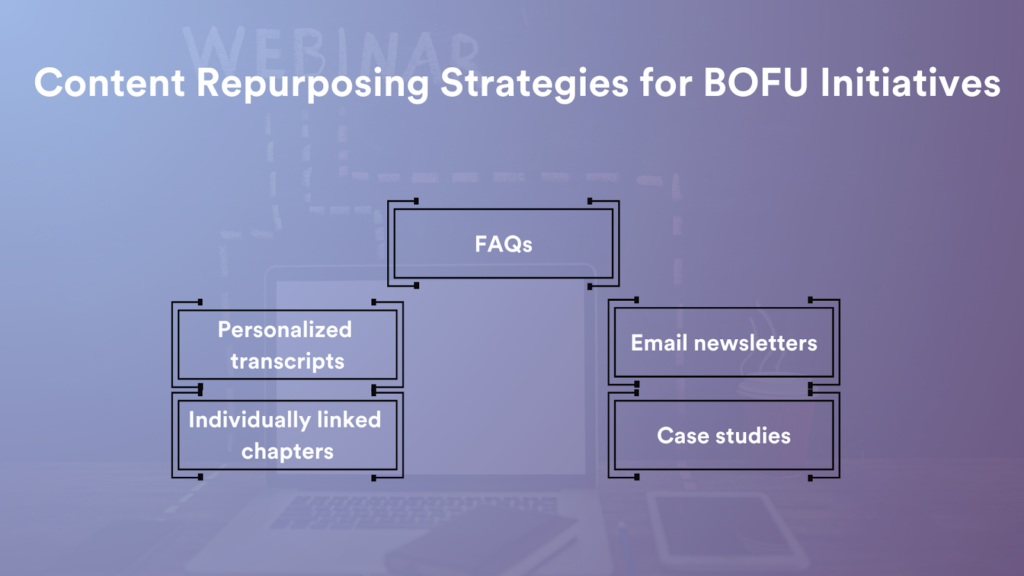
8. FAQs
Leverage the Q&A sessions, polls, and chat interactions from your webinars to create a comprehensive list of questions and answers related to the topic. Draft detailed responses to these questions, addressing common concerns and providing valuable solutions.
You can also further personalize these FAQs to address the specific needs and concerns of hot leads or potential customers. This tailored approach helps to overcome objections, creates a positive impression, and encourages prospects to engage further and move towards a decision.
9. Personalized transcripts
Provide personalized transcriptions of the webinar content to your attendees. Use engagement analytics to identify parts of the session where they were most active and involved.
Create an on-demand video and a text-based transcript highlighting these key segments, and share it with your audience.
This attention-to-detail strategy not only engages attendees effectively but also fosters a progressive environment, helping your potential customers make informed decisions.
10. Email newsletters
Repurpose your edited and customized on-demand webinar content into a targeted email series designed to nurture leads and maximize engagement.
Each newsletter can feature key insights from the webinar, tailored FAQs, industry-specific case studies, speaker quotes, and actionable tips. You can also incorporate links to other relevant on-demand sessions.
By delivering these valuable, repurposed content pieces, you can guide prospects through the funnel, addressing their specific needs and driving them toward conversion.
11. Individually linked chapters
Segment the webinar into specific chapters or segments, each addressing different aspects of the topic. Include these segmented videos and transcripts in your nurture campaigns to offer more tailored content.
Breaking the webinar into individually linked chapters or segments makes the content user-friendly and easy to consume by allowing prospects to easily find and focus on the information most relevant to them.
12. Case studies from customer webinars
Customer-centric webinars and customer stories are extremely valuable. You can transform these into case studies and share them as both an on-demand webinar and documented success stories.
By providing industry-specific case studies and related on-demand content, you engage potential customers more effectively. This helps to build trust and demonstrate real-world applications of your solutions, improving the likelihood of conversion.
Top Tips to Fine-Tune On-Demand Webinars Repurposing and Content Strategy
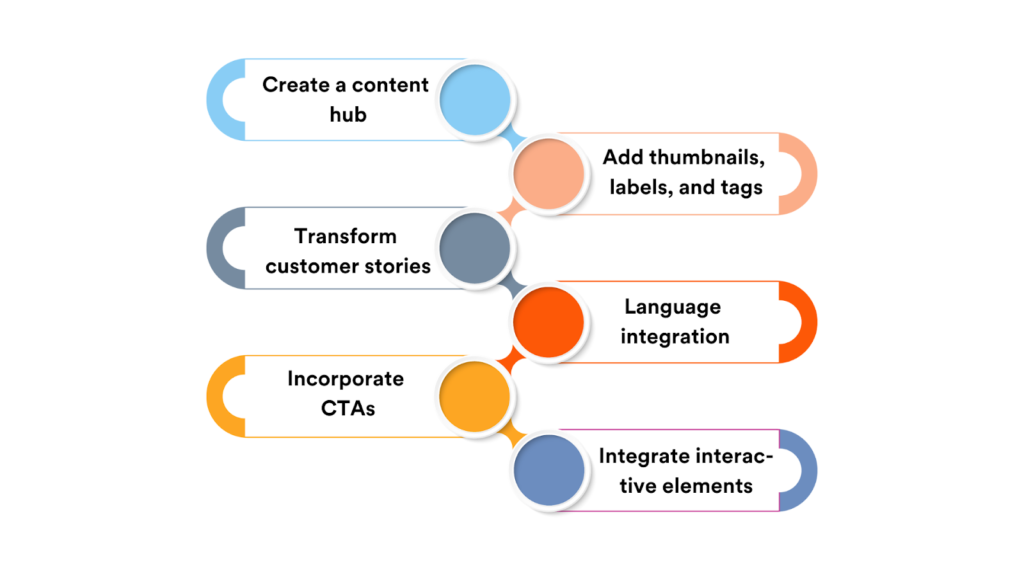
1. Create a content hub
A content hub centralizes all your repurposed webinar materials in one easily accessible location. It acts as a knowledge repository where users can explore webinar replays, resources, and related content.
By organizing webinars in a structured hub, you not only increase content discoverability but also improve SEO, driving better organic traffic. This makes it easier for your audience to find relevant content and navigate through your offerings.
2. Add thumbnails, labels, and tags
Custom thumbnails, labels, and tags are essential for enhancing the visual appeal and searchability of your on-demand webinars.
Thumbnails should be eye-catching and relevant to the webinar topic, while labels and tags help in categorizing content by theme, industry, or audience type. This allows viewers to easily locate more recommended and relatable content that suits their interests, driving higher engagement rates.
3. Transform customer stories into autonomous webinars
Repurposing customer success stories into autonomous, self-paced webinars is highly resourceful for your business. Customer-centric webinars influence prospects by presenting relatable, outcome-driven narratives that resonate with their needs.
These webinars serve as a credible source, showcasing the practical value of your solutions and helping prospects evaluate options, which ultimately aids in finalizing their decisions.
4. Language integration
Incorporating multilingual support in your on-demand webinars ensures that your content reaches a broader, global audience.
Adding subtitles in various languages makes the content more accessible to non-native speakers, improving engagement and reducing barriers for international viewers.
You can also leverage AI-powered voiceover solutions to narrate the on-demand webinars and other repurposed versions of the original content in different languages and incorporate these in marketing and nurture campaigns.
5. Incorporate CTA prompts
Including clear and compelling calls-to-action (CTAs) is essential for guiding viewers toward the next step, whether it’s signing up for a demo, downloading a resource, watching the on-demand version, or registering for another webinar.
Strategically placing CTA buttons or pop-ups at key moments during the webinar or within follow-up campaigns ensures continued engagement, even after the viewer has finished watching or reading the content.
6. Integrate interactive elements
Integrating interactive elements such as integrated polls, chatbots for Q&As, or clickable content in on-demand webinars.
These elements can be embedded within the webpage or platform where your on-demand webinars or repurposed content are hosted.
By adding interactivity, you encourage engagement and make the experience more dynamic, helping viewers stay actively involved with the content.
Frequently asked questions
On-demand webinars play a crucial role in lead generation by providing valuable, accessible content that can attract prospects long after the live session and guarantee a consistent engagement.
They offer evergreen opportunities for engagement, lead generation, nurturing, and conversions.
On-demand webinars can be hosted on a variety of platforms, including your own website, dedicated content hubs, YouTube, social media platforms, and webinar platforms like Airmeet and Webex.
Repurposed content, like short video clips, infographics, summaries, key takeaways, speaker quotes, and bite-sized highlights, is ideal for sharing on social media platforms like LinkedIn, Twitter, Instagram, and Facebook to boost visibility and engagement.



